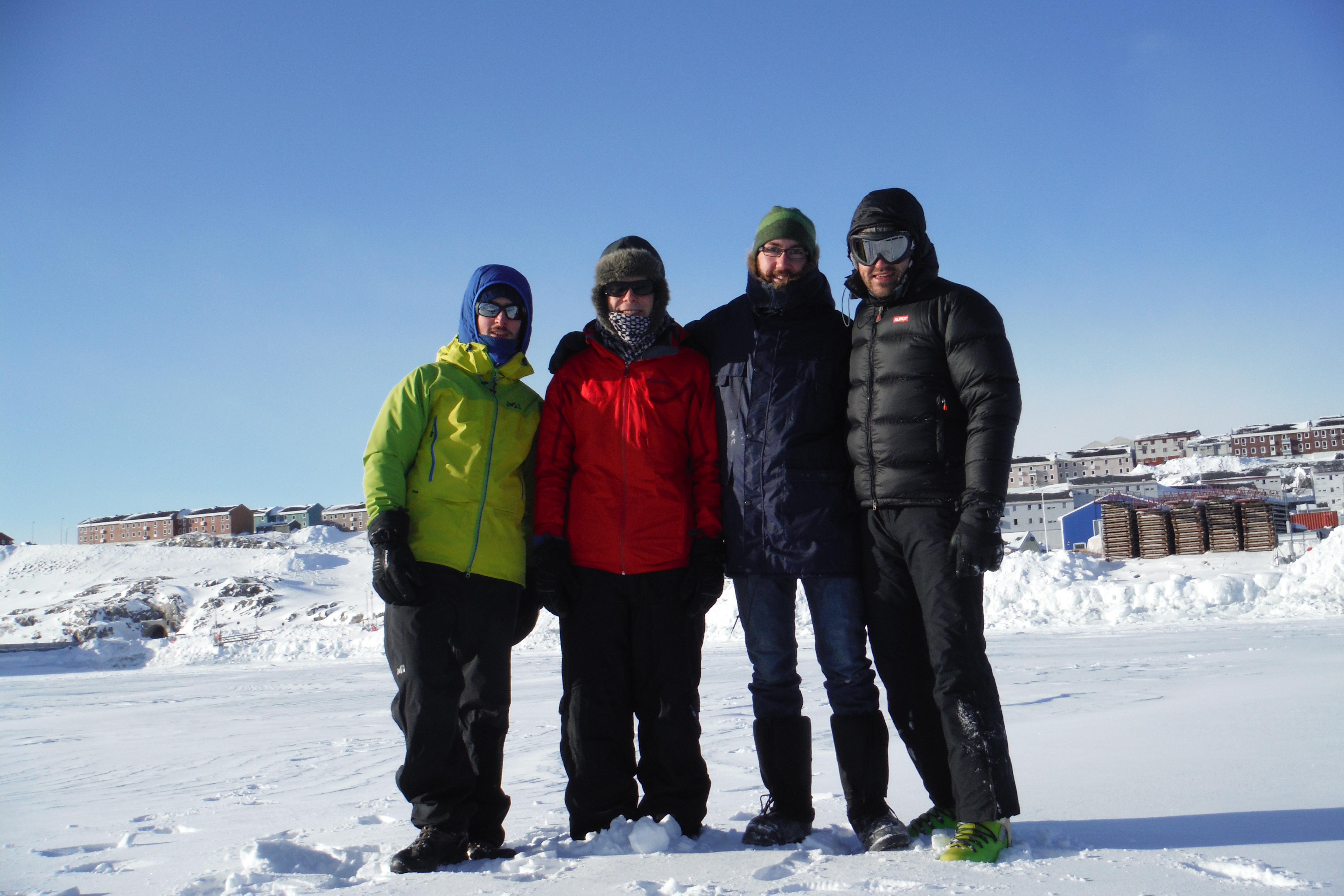Hands-On Learning About Snow and Sea Ice
Written By Keegan Smith, MSc. Graduate Student in Geography
Seen from a high-flying plane, the Greenland ice sheet is a vast expanse of white. Beginning our descent, we can see what we believe to be tiny cracks in the ice. Descending further, the illusion is shattered as we realize that we are staring down at yawning crevasses, each cutting deep into a slab of ice thousands of metres thick. The sudden appreciation of scale is dizzying.

A view of blowing snow out of the window of the Greenland Institute of Natural Resources (GINR) residence building. This is my favourite kind of weather.
It is February 2015, and I am travelling with fellow DGES M.Sc. student Jill Rajewicz to attend the Snow-Covered Sea Ice field course in Nuuk, Greenland’s capital. The course has been organized by Dr. John Iacozza, an instructor with the University of Manitoba and a specialist on snow-covered sea ice, with support from instructors from Canada, Denmark, and Greenland. Through the Arctic Science Partnership, students have come to Nuuk from around the Northern Hemisphere.

Overlooking Nuuk Old Town from the statue of Nuuk’s founder, Lutheran missionary Hans Egede (not visible, behind photographer). The red Nuuk Cathedral is visible in the mid-ground. Photo credit: Jill Rajewicz
Though we’ve been travelling for hours, our excitement is palpable when we step onto the tarmac of Kangerlussuaq airport. It is my first time standing north of the Arctic Circle, and I am glad that we get to walk outside when changing aircraft.
Air Greenland has only one Airbus A330, which spends most of its time commuting to Copenhagen, Denmark. Due to mountainous terrain and challenging weather, Nuuk airport cannot handle jet airliners. To get there, we must transfer to more maneuverable Dash-8 propeller planes. We board these at Kangerlussuaq, which, at the head of a long fjord, is an ideal landing strip for the bulky airbuses.
As we approach Nuuk airport, I stare at land-fast ice in the fjords we fly over. “Land-fast” means that this ice is bound to the coastline, and doesn’t move like open-water pack ice. As part of our course, we will be conducting fieldwork on land-fast ice in Nuuk ‘s Old Harbour. The ice is fascinating, but I am traveling to study the snow. I’m already full of questions for John. How is the snow typically distributed on sea ice? How is it studied in the field? What are its thermal and optical properties?

Carleton M.Sc. student Keegan Smith standing under the Kangerlussuaq airport signpost, north of the Arctic Circle.
Once on the ground in Nuuk, I unpack at GINR’s accommodations before exploring with Jill. With a bus service that runs throughout the day, a large cultural centre and museum, and even a shopping mall, I’m amazed at how busy the city is. Later, we learn that a hydroelectric dam provides most of Nuuk’s energy, that the city has a swimming pool warmed by heat from a municipal waste incinerator, and that it has its own brewery. I can’t help but think that there’s something for every geographer here…
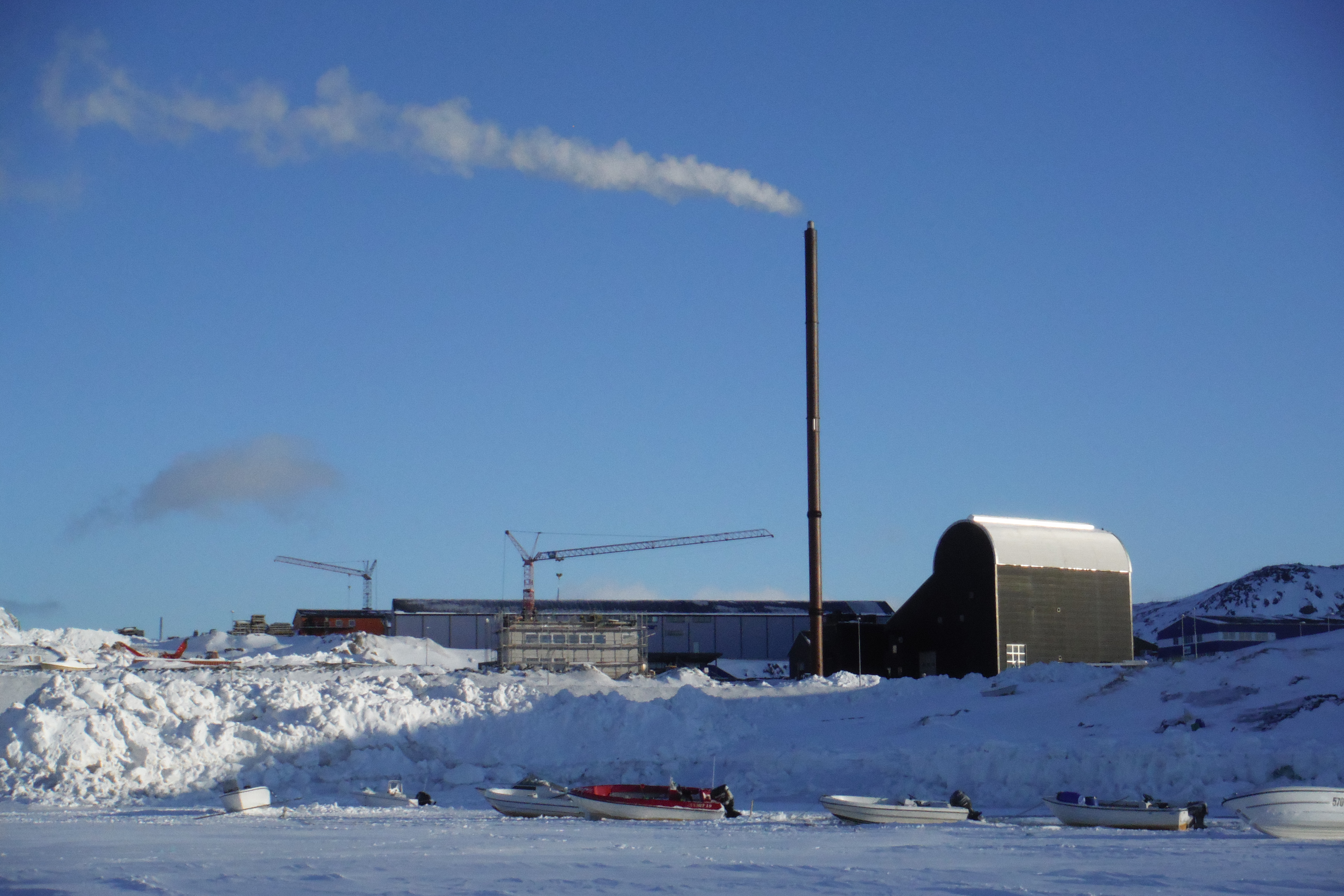
The waste incinerator, as seen from Nuuk Old Harbour. Heat from this incinerator warms a nearby indoor swimming pool, which stays open around the year.
Photo credit: Maxim Lamare
The course begins the next day at the Greenland Institute of Natural Resources (GINR), which has rented their accommodations out to us for the week. Living with a group of international graduate students with similar research interests is both fun and intimidating. Experience levels range – some, like Jill, have seasons of Arctic fieldwork under their belts. Others, like Maxim Lamare, have been studying the properties of sea ice in laboratory settings for years, but have never actually stood on ice on the ocean. But as several languages spin around the dining table, it becomes clear that the common theme is enthusiasm. We’re very lucky to be here.
Lectures run through the day (with obligatory breaks for coffee). John, a specialist in polar bear habitat, teaches us about the geophysics of snow and ice. Lars Lund-Hansen, a professor of biology at Aarhus University in Copenhagen, teaches us about sea ice optics and ecosystems. We have read papers about climate monitoring by Soviet drifting stations during the cold war. We have seen videos showing the instructors’ trips to the Arctic and Antarctic oceans.
Of course, you can hear lectures anywhere. We are here for experiential learning, which we get through fieldwork, lab time, and (perhaps surprisingly) lunch. Lunch at GINR is not a modest affair, beginning with a trumpet blast to alert the whole building. Staff members and guests quickly gather at the doors to the lunchroom, forming an orderly line and conversing to their neighbours in many languages – a meeting of cultures and minds.
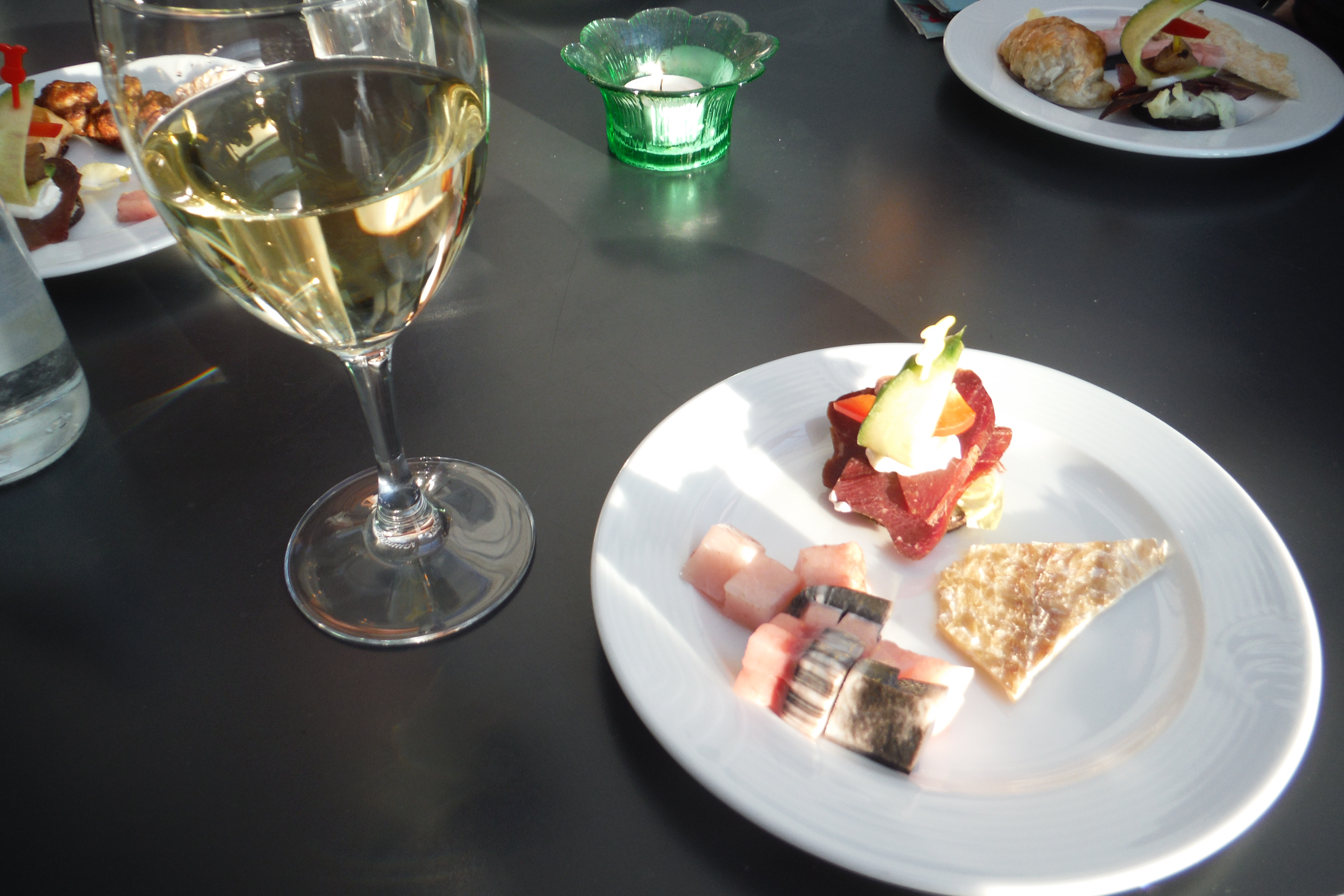
Appetizers at GINR’s lunch spread. Clockwise from the top of the plate: Musk Ox canapé, dried cod, and maktaaq – the skin of a narwhal.
Photo credit: Maxim Lamare.
The food seems to symbolize the spirit of this meeting; traditional Greenlandic country foods, such as whale skin and seal blubber, are served alongside Scandinavian fare, such as meatballs and dried cod. Food is a prominent research topic at GINR because of its importance to Greenlanders. Food security, economy, and culture are all linked here through the halibut and prawn fisheries, the social importance of hunting and traditional foods, and the high cost of imports to the Arctic.
As we tour the Institute over the next several days, we are invited several times to conduct research at GINR, and several researchers show us what they are working on. The projects are diverse, but many focus on the physical and biological systems of the ocean and sea ice. Mala Broberg is a Greenlandic student in our course who has been on one of the research trawlers. He describes the experience to us, telling us that in addition to research experience, students are allowed to keep a share of the catch for their freezers.
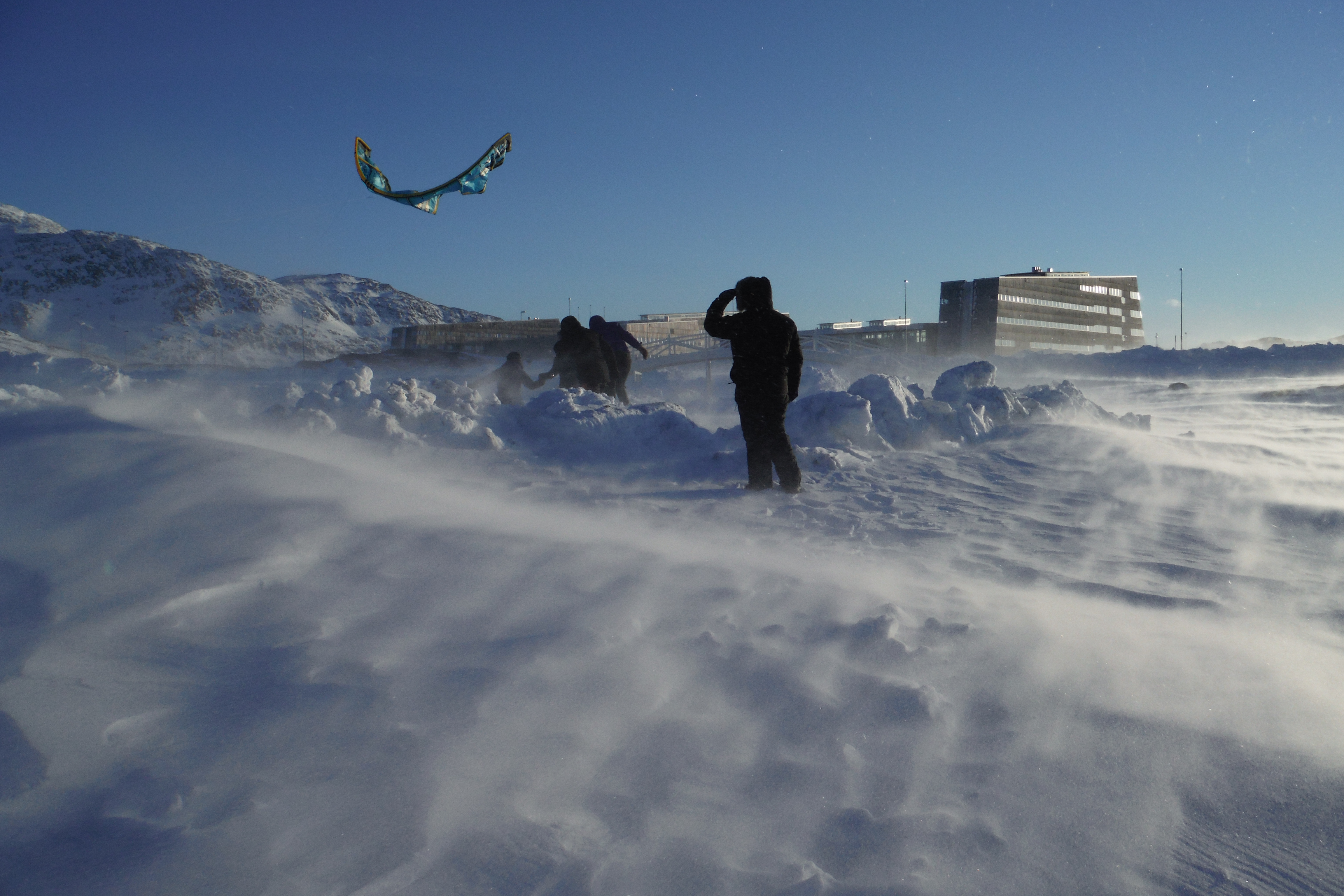
Students watch a local kite-skiing during an orienteering exercise conducted as part of the course.
Photo credit: Maxim Lamare.
We also get our fieldwork on the harbour. We have three exercises to complete in the field – a snow survey, a snowpit, and an ice core. For the survey, we sample snow depth periodically along two lines, each arrayed at 45° to the prevailing winds. We dig the snowpit to take measurements of temperature, snow density, and grain size from top to bottom in the snowpack. These measurements together can tell us how heat and light are transferred between the ocean and the atmosphere, buffered by the snow and ice.
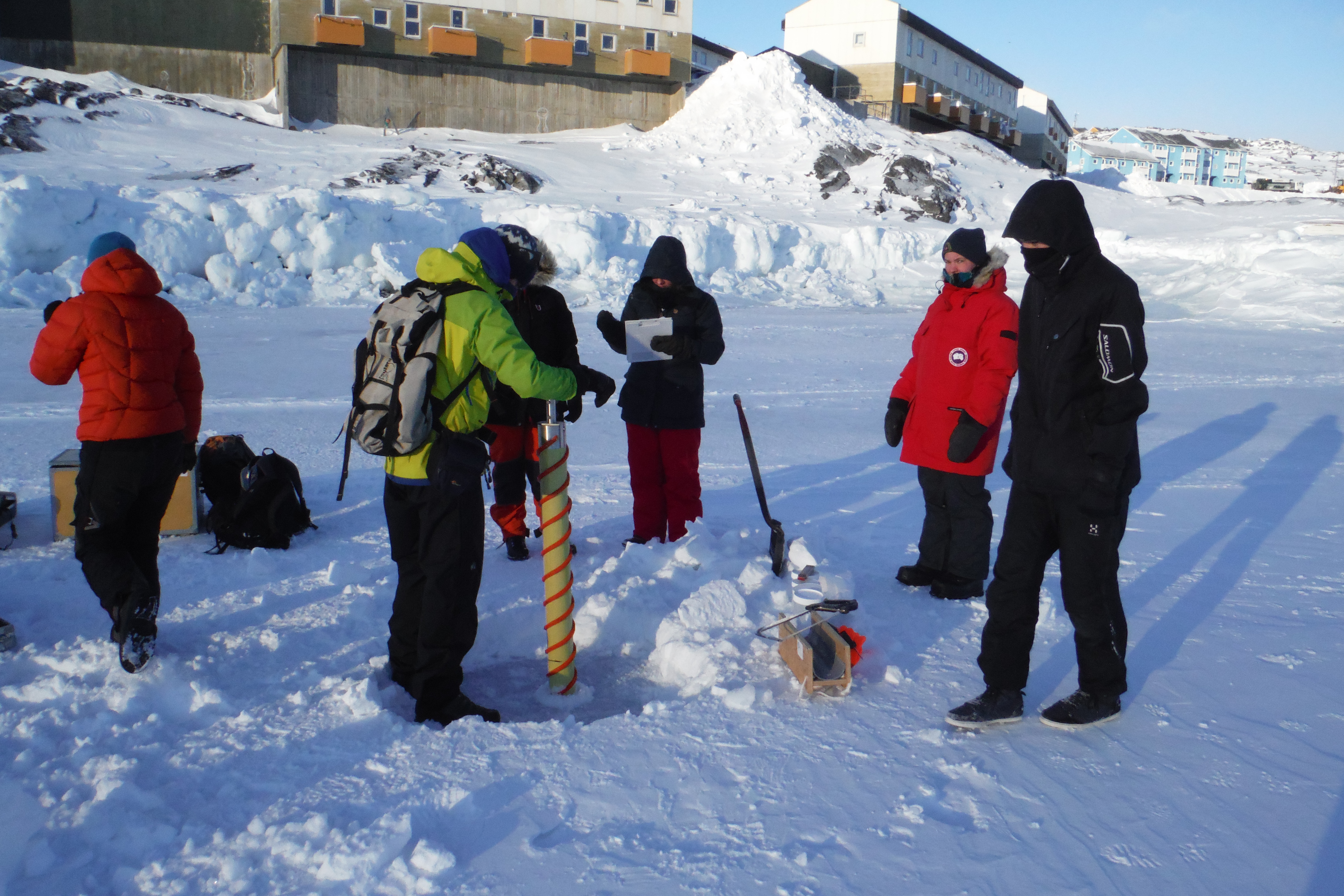
Students extract an ice core from Nuuk Old Harbour using the Kovacs corer (the long orange barrel, centre). This corer is being hand-turned, but they can be driven by power tools for greater speed, and can be used with extensions to core much thicker ice. Photo credit: Maxim Lamare
Finally, we use a Kovacs corer to cut out an ice core, and we section this core into segments by depth. We take these segments into the GINR lab and let them melt, allowing us to measure pH, salinity, and chlorophyll content. Chlorophyll is the main pigment that algae use for light absorption and photosynthesis, and chlorophyll concentration is a measure of algae biomass. Based on the amount of light absorbed in our melted-ice samples, we can tell that the chlorophyll concentration, and thus the number of algae, is highest at the interface between the ocean and the ice (i.e. the bottom of the core).
At the end of the course, we celebrate… with Thai food! Because where else in the world are you going to try musk ox curry? The night ends with heartfelt goodbyes. Some of the other students are staying for an ice-safety course over the next few days, but Jill and I catch a plane back to Ottawa (by way of Kangerlussuaq, and then Copenhagen, and then Toronto) to work on our thesis proposals and mark papers.
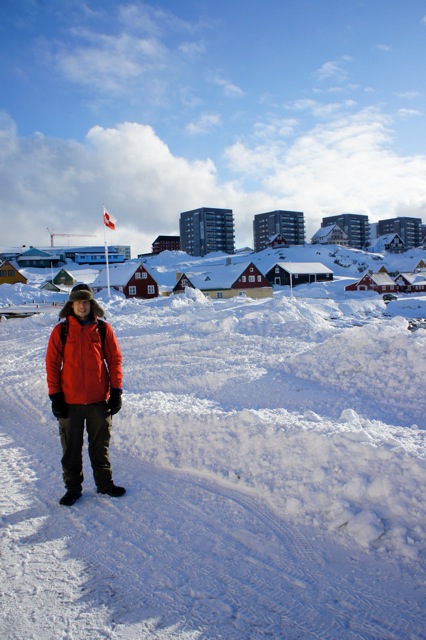
Standing by the harbor in Nuuk’s Old Town on a clear day. Note the more traditional Scandinavian-style houses in the mid-ground, with larger modern residential buildings in the background.
Photo credit: Jill Rajewicz
Having harboured dreams of visiting Greenland since childhood, this was an incredible experience for both Jill and I. Thanks are due to Dr. John Iacozza for working so hard to make the course a success, and to the GINR staff for being so welcoming to the group. I also want to thank the Geography Department, the Faculty of Graduate and Postdoctoral Affairs, and the Graduate Students’ Association, as well as my supervisor, Dr. Murray Richardson, for helping me to fund the trip.


